Poicephalus
| Poicephalus parrots | |
|---|---|
 | |
| Senegal parrot eating fruit | |
| Scientific classification | |
| Kingdom: | Animalia |
| Phylum: | Chordata |
| Class: | Aves |
| Order: | Psittaciformes |
| Family: | Psittacidae |
| Tribe: | Psittacini |
| Genus: | Poicephalus Swainson, 1837 |
The genus Poicephalus comprises ten species of parrots native to various regions of the Afrotropic ecozone, including Sub-Saharan Africa, ranging from Senegal in the west, Ethiopia in the east, and to South Africa in the south.[1][2] Several of the species exist in slightly different forms (or subspecies).
They are stocky birds with short broad tails and relatively large heads and beaks for their size. (Poicephalus, from the Ancient Greek, literally means made of head). Several of the species show marked sexual dimorphism, where the adult male and female birds can be easily identified from variations in feather colouration, but in other species there is no sexual dimorphism or the differences are not so marked. They feed primarily on seeds, fruits, nuts, and leafy matter.
The Cape parrot and red-fronted parrot form a superspecies complex.[3]
The Senegal parrot, Meyer's parrot, red-bellied parrot and the brown-headed parrot are popular as pets because they are easier to keep in apartments, being generally quieter and smaller than most other companion parrots. Some Poicephalus parrot species are rare and not known or rare in captivity.
Taxonomy
The genus Poicephalus was introduced by the English naturalist William John Swainson in 1837.[4] The type species was subsequently designated as the Senegal parrot.[5] The name is from the Ancient Greek phaios "grey" and -kephalos "headed".[6]
The genus contains ten species.[7]
- Red-fronted parrot, P. gulielmi
- Yellow-fronted parrot, P. flavifrons
- Brown-necked parrot, P. fuscicollis
- Cape parrot, P. robustus
- Meyer's parrot, P. meyeri
- Rüppell's parrot, P. rueppellii
- Brown-headed parrot, P. cryptoxanthus
- Niam-Niam parrot, P. crassus
- Senegal parrot, P. senegalus
- Red-bellied parrot, P. rufiventris
Species
| Species | |||
|---|---|---|---|
| Common and binomial names | Image | Description | Range |
| Senegal parrot
(P. senegalus) |
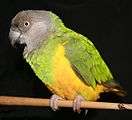 |
Grey head, green back and chest. Yellow, orange or red belly depending on subspecies. | Africa |
| Meyer's parrot
(P. meyeri) |
Green, yellow under wings. Six subspecies with variable yellow colouration. | Africa | |
| Red-bellied parrot
(P. rufiventris) |
Mostly green and grey. Male has red belly. | Africa | |
| Brown-headed parrot
(P. cryptoxanthus) |
 |
Mostly green and grey. Yellow under wings. | Africa |
| Red-fronted parrot
(P. gulielmi) |
Mostly green, variable amount of red on head and shoulders depending on subspecies | Africa | |
| Cape parrot
(P. robustus) |
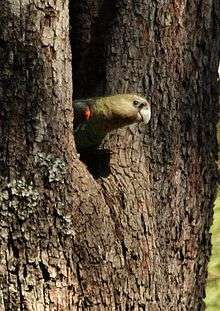 |
Mostly green, grey or brownish head and necks | Africa |
| Brown-necked parrot
(P. fuscicollis) |
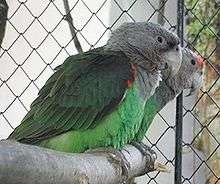 |
Mostly green, grey or brownish head and necks | Africa |
| Rüppell's parrot
(P. rueppellii) |
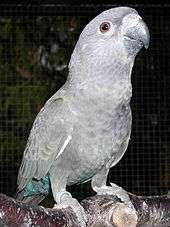 |
Overall dark brown colour, head is dark greyish, yellow on legs and leading edge of wings, female has blue rump and lower back | Africa |
| Yellow-fronted parrot
(P. flavifrons) |
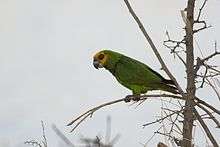 |
Mostly green with a yellow head | Ethiopia |
| Niam-Niam parrot
(P. crassus) |
Mostly green with a brown head | Africa | |
References
- ↑ Taxonomy of Poicephalus parrots
- ↑ Map showing countries of Sub-Saharan Africa
- ↑ Massa, Renato; Sara, Maurizio; Piazza, Matteo; Di Gaetano, Cornelia; Randazzo, Margherita; Cognetti, Goffredo (2000). "A molecular approach to the taxonomy and biogeography of African parrots" (PDF). Italian Journal of Zoology. 67 (3): 313–17. doi:10.1080/11250000009356330. Retrieved 5 December 2010.
- ↑ Swainson, William John (1837). On the Natural History and Classification of Birds. Volume 1. London: John Taylor. p. 301.
- ↑ Peters, James Lee, ed. (1937). Check-list of Birds of the World. Volume 3. Cambridge, Massachusetts: Harvard University Press. p. 224.
- ↑ Jobling, J.A. (2018). del Hoyo, J.; Elliott, A.; Sargatal, J.; Christie, D.A.; de Juana, E., eds. "Key to Scientific Names in Ornithology". Handbook of the Birds of the World Alive. Lynx Edicions. Retrieved 4 April 2018.
- ↑ Gill, Frank; Donsker, David, eds. (2018). "Parrots, cockatoos". World Bird List Version 8.1. International Ornithologists' Union. Retrieved 4 April 2018.